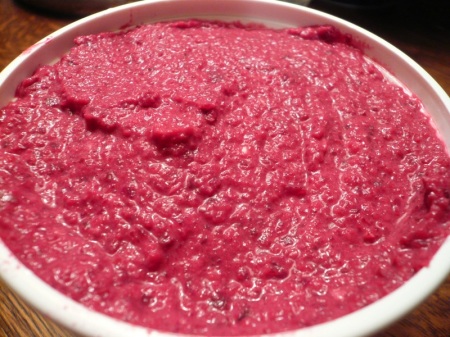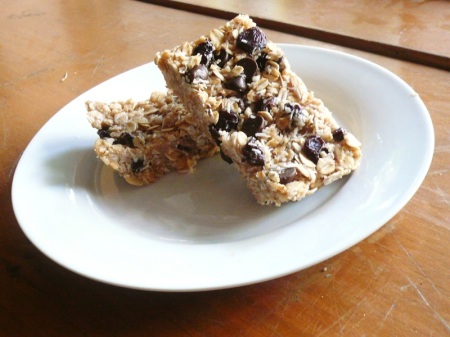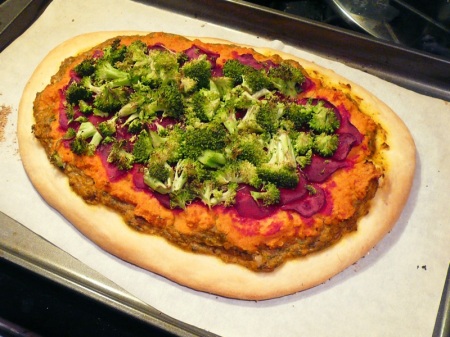Spoiler alert: This post contains secrets. More specifically, bread baking secrets.
As some of you already know, for many months now I’ve been making all my own bread at home from scratch. I’ve posted recipe after recipe after recipe for bread on this here blog, but I’ve never really posted an all-purpose beginner’s guide to baking bread. Granted, I’m still far from being a pro at this, but I have picked up many tricks over the months, and now I want to share those tricks with you.
A proviso: This guide is for making basic, everyday bread; it’s not a guide for making fantastic, artisanal bread. Now don’t get me wrong: artisanal bread is awesome, and completely within the average person’s means. However, it also takes a lot of precision, time, and equipment that the average home baker probably doesn’t (yet) have. (If you do want to get into artisanal baking, however, the best place I know of to start is Peter Reinhart’s The Bread Baker’s Apprentice.)
The fact is, if you’re just looking to bake just some good bread, rather than amazing bread, then baking bread is super easy, and fairly hard to screw up. Yes, you’ll have plenty of little mishaps along the way, but rarely will any of those mishaps make your end product wholly inedible. So here they are: all my essential tips and tricks to baking good, everyday sandwich or snacking bread at home!
My 5 Essential Basic Bread Baking Tips
To begin things, here are five basic yet absolutely essential tips that every home baker should know.
1. Give yourself four hours
Between kneading, rising, shaping, proofing, and baking, even your most basic bread will take you at least three hours, so I like to make sure I have at least four hours in my schedule whenever I’m baking bread. These won’t be four hours of active time, but they should be four hours where you’ll more or less be at home and by your kitchen.
2. Always use instant yeast
This is a simple trick that I’ve heard several pros recommend. Instant (or rapid-rise) yeast, unlike regular yeast, does not need to be proofed (that is, mixed with water) beforehand; rather, you just add it directly to the flour at the beginning, saving you time and effort. Plus, since instant yeast is essentially just more potent yeast, it only helps your breads rise better.
3. You can never overknead
…at least if you’re kneading by hand. This is not exactly true, but if you’re a novice baker, you’re in much greater risk of not kneading enough. Seriously, to overknead by hand would require you to be kneading for over 10, probably 15 minutes, and your hands are going to get tired long before that.
4. Be responsive
The real key in successfully baking bread at home is being attentive to how your dough is performing and reacting appropriately. Even beyond ingredient measurements, there are so many factors that will affect your dough—temperature, humidity, brand of flour, freshness of yeast, and so on—and because of this, you need to feel comfortable veering away from any recipe when things don’t look quite right. Basically, this means adding more flour when the dough is looking too wet and adding more water when the dough is looking to dry. With practice, you’ll soon develop a sense of when a dough just feels right.
5. Let your bread cool
One of the simplest mistakes novice bakers will make is not allowing a freshly baked loaf sufficient time to cool. A lot of internal baking will continue during cooling, and cutting your bread too early will disrupt that process and potentially result in a partially unbaked loaf. I usually give my bread about an hour; this will give it enough time to cool, but still leave it a bit warm for that delectable first bite.
My Basic Everyday Bread Recipe & Procedure
Now that you’ve got the basic tricks down, we’re ready to start making some bread!
Essentially, bread is just three things: flour, yeast, and water. To this you will sometimes add salt (for flavour), oil (for texture), and sugar (for flavour, and to react with the yeast). In this recipe, I will just be using flour, yeast, water, and salt. This recipe is still tasty and satisfying, though not perhaps extraordinary. However, from this basic recipe you’ll be able to go off and make all sorts of other breads by adding toppings, trying different flours, and so on. Anyway, without further ado, here we go!
1. Mix your dry ingredients: flour, yeast, and salt
Start with 3.5 cups of flour, 2 tsp of yeast, and 1 tsp salt. (You will probably need more flour as you’re kneading.) As for choice of flour, it’s up to you. However, some tips: If you want to make white bread, try to procure some bread flour, which has a higher gluten content and will form a much better dough. If you want to make wheat bread and are using normal whole wheat flour, you will probably want to use 50% whole wheat flour and 50% white or bread flour; normal wheat flour doesn’t usually work quite right. If you want to make wheat bread and are lucky enough to live in Ontario, try to procure some Red Fife flour, which can be used solely, without adding any white flour, and is naturally delicious to boot. And if you want to make a spelt bread, I’ve had luck using spelt flour alone.
2. Add your wet ingredient: water
You’ll want about 1.25 cups of lukewarm water. Throw this right into your flour mixture.
3. Start mixing things together
In the bowl, mix everything together with a rubber spatula or some such utensil. The goal here is not to get everything to come together but just to form a ball-ish mass with the majority of what you have, as pictured above.
4. Get your dough on the counter
The reason you don’t need to worry about getting everything mixed together perfectly in the previous step is because the real incorporation work happens on the countertop, not in the bowl. So once you’ve gotten a rough ball formed in your bowl, turn it upside down and dump in our your counter, scraping out the remaining bits of flour on top. Now the kneading begins…
5. Start kneading
Kneading, in simplest terms, is pressing your dough together—that is, more like working out a knot on someone’s back than giving someone a backrub. You really want to put all your arm muscle into this, and to do so for a while, at least 5 minutes, but likely closer to 10. A basic kneading procedure is to fold your lump of dough in half, press it in good, turn the lump 90 degrees, and then repeat the fold, press, turn sequence. As you go, continually incorporate those remaining bits of flour left over from the bowl, kneading your dough into them and pressing them in. The picture above shows a ball of dough about midway through the kneading process.
6. Finish kneading
Like I said above, kneading requires you to be responsive. As you knead, you’ll notice your dough changing feel. In the end, your dough should be tacky but not sticky. If it’s looking too sticky (if clumps of dough are continually sticking to your palms as you knead), throw a handful of flour on top and knead that in, repeating if necessary. If it’s feeling too dry, wet your hands and knead for a bit, repeating if necessary. Definitely be more cautious when adding water than flour, as doughs are much more sensitive to additions in water content. Once your dough looks something like the dough pictured above, you’re done!
7. Oil it up
Now you’re ready to take a break and let yeast do its magic. In preparation for your first rise, lightly oil a big bowl. What oil you use doesn’t really matter, but you should use a different bowl than the one you used for mixing, since you want the bowl to be clean and dry. Once your bowl is oiled, toss your ball of dough around in the bowl, getting oil on every part of its surface.
8. Let it rise
Now simply put a towel on top of that bowl and walk away. For about two hours.
9. Come back
After about two hours, your dough should’ve about doubled in size. Sometimes it’ll double in less time, sometimes it’ll take more, but two hours is generally a good benchmark. Now you’re ready to shape your dough and give it its second rise.
10. Punch it down, flatten it out
The first thing you want to do now is punch—literally punch—your dough down. Just slam your first straight down into your big risen dough. (For you keeners out there, punching your dough down gets the gas out, making for a dense loaf in the end; if you want an airier bread, you actually want to skip punching down and avoid handling your dough as much as you can in this step.) Next, dump your collapsed dough onto the counter and pat it down into a flat oblong rectangle, as pictured above.
11. Shaping!
There are countless options for shaping bread, but all of them have silly French names like boule or bâtard or baguette or couronne or épi or fendu or fougasse or tabatière or auvergnat. The dough you’ve made could be used to make any of these shapes, but I’m going to show you how to shape it into a bâtard, as it’s by far the simplest and seems to work well with this dough recipe. The shaping process proceeds into two simple folds—to begin, fold the long bottom side of your oblong up, letter-style, like so:
Press the seam lightly to create a seal. Next, fold the top side down in a similar fashion:
Pinch this seam well, and maybe neat up the ends, if necessary:
And believe it, that’s all there is to it! You’re already done.
12. Let it rise, again
Now your dough must go through its second rise, or what’s called proofing. The good news is that the second rise is much shorter than the first: I usually give my doughs about 45 minutes. If you’ve got a baking stone and peel, you’ll want to proof your dough on the peel; if you’ll be baking on a normal baking sheet, line the baking sheet with parchment paper and proof on that. In either case, spread a small amount of fine cornmeal or semolina flour below your dough. Cover with a towel and let rise.
Now’s also a good time to preheat your oven! Set it to 425 F. If you’ve got a baking stone, making sure you’re preheating that at the same time.
13. Come back, again—and bake!
After 45 minutes or so, your dough should’ve grown a bit; it needn’t, and probably shouldn’t be a full doubling this time. You’re now ready to bake! Before putting your dough in the oven, you may want to score, or slash, it. I usually don’t, but that’s because I haven’t found it necessary with the breads I’ve been making. If you wish to do so (it can often assist with the baking process), simply lightly run a serrated bread knife diagonally or laterally across the width of your dough; two or three slashes is good. Now put your dough in the oven, either directly by moving the baking sheet it was proofing on, or by shaking it from your peel to your baking stone.
Bake for 5 minutes at 425 F, and then lower the oven heat to 375 F and bake for another 35 minutes.
14. Take it out, let it cool
After 40 minutes of baking, your bread should be done. There are numerous pieces of wisdom I’ve been told for how to know when a loaf is baked, but anything short of an internal thermometer is not much more than an old wives’ tale, and I’ve just never really understood what it means for a loaf to “sound hollow” when you tap it and besides the loaf is like 400 degrees why do you want to touch that. Anyway, 40 minutes should be about good, though you could go a little longer if you want a darker crust.
Let your bread cool on a cooling rack (not as pictured) for about an hour. As I said above, it really is essential that you let your bread fully cool, as a lot of internal baking still goes on after it comes out of the oven.
15. Dig in!
After your loaf is cooled, you’re finally ready to slice it up, chow down, and enjoy! Congratulations!
My 3 Advanced Bread Baking Tips
As a short coda to this horribly long post, I wanted to leave you with three simple additions you can make to your kitchen if you’re looking to step up your bread baking production. You can still make totally delicious bread without these additions, as I indeed did for years, but now that I have them, I can really see what a world of difference they make.
1. Get a kitchen scale
I didn’t have one of these for years, but even for casual bread baking it makes things so much simpler. All dough formulas are actually calculated by weight, not volume, and with the varying densities and varieties of flour, measuring things out by cups is never a sure-fire way to go. All this means is that you’ll need to do some fiddling while kneading, adding a little flour or water when necessary. A basic kitchen scale alleviates this need, and lets you reliably mix up perfect doughs again and again.
If you have a kitchen scale, I’ll let you know that my magic by-weight bread formula is: 500 g flour, 2 tsp yeast, and 1 tsp salt for the dry ingredients, and 50 g wildflower honey with 250 g of water for the wet. Comes out perfect every time.
(And if you’re wondering why wildflower honey is appearing on a so-called “vegan” blog, that is definitely a story for another day.)
2. Get a baking stone
Baking stones really do make your breads bake better, providing hotter and more consistent heat to your bread throughout the baking process. It’s a simple, albeit heavy, purchase, but it’ll really step up the quality of your loaves. Plus, you can make pizzas on it too!
3. Get a peel
Actually, this is just an addendum to the last tip, because if you’re going to use a baking stone, you should really be using a baking peel as well. It’s simply the best way to transfer your dough to the stone; any other method will disrupt the dough too much. Plus, you can transfer pizzas with it too!
And that’s all for today, folks. Sorry that it took me three months from my last post to write this—but if you’ve read down this far, you probably can understand why.
Until we eat again,
Willie




























